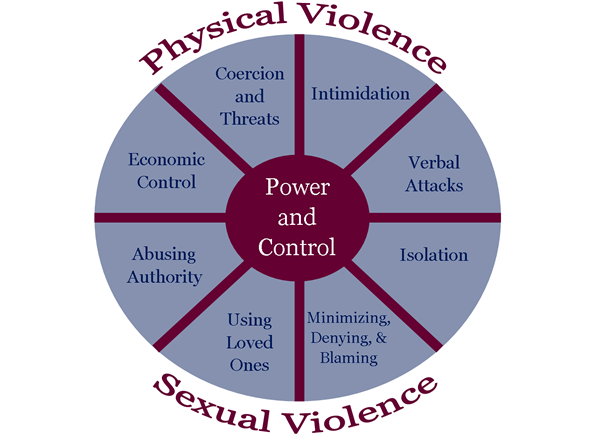
Domestic violence is a pattern of coercive behavior characterized by the domination and control of one person over another, usually an intimate partner, through physical, psychological, emotional, verbal, sexual, and/or economic abuse.
Types of Abuse
Domestic violence can take different forms, but its purpose is always the same: Abusers want to control their domestic partners through fear. They do this by abusing them physically, sexually, psychologically, verbally, and economically.
Physical Abuse:Hitting, Slapping, Kicking, Choking, Pushing, Punching, Beating
Verbal Abuse:Constant criticism, Mocking, Making humiliating remarks, Yelling, Swearing, Name-calling, Interrupting
Sexual Abuse:Forcing sex on an unwilling partner; Demanding sexual acts that the victim does not want to perform; Degrading treatment
Isolation: Making it hard for the victim to see friends and relatives, Monitoring phone calls, Reading mail, Controlling where the victim goes, Taking the victim’s car keys, Destroying the victim’s passport
Coercion: Making the victim feel guilty, Sulking, Manipulating children and other family members; Always insisting on being right; Making up impossible rules and punishing the victim for breaking them
Harassment: Following or stalking, Embarrassing the victim in public, Constantly checking up on the victim, Refusing to leave when asked
Economic Control: Not paying bills, Refusing to give the victim money, Not letting the victim work, Interfering with the victim’s job; Prohibiting the victim from going to school; Not allowing the victim to learn a job skill; Refusing to work and support the family
Abusing Trust: Lying, Breaking promises, Withholding important information, Being unfaithful, Being overly jealous, Not sharing domestic responsibilities
Threats and Intimidation: Threatening to harm the victim, the children, family members and pets,
Using physical size to intimidate, Shouting, Keeping weapons and threatening to use them
Emotional Withholding: Not expressing feelings, Not giving compliments, Not paying attention, Not respecting the victim’s feelings, rights and opinions, Not taking the victim’s concerns seriously
Destruction of Property: Destroying furniture, Punching walls, Throwing or breaking things, Abusing pets
Self-Destructive Behaviors: Abusing drugs or alcohol, Threatening self-harm or suicide, Driving recklessly, Deliberately doing things that will cause trouble
Who are Victims?
Statistically, Most Victims Are Women. Men can be victims too.
- 85% of all domestic violence victims are women who are abused by their husbands or boyfriends.
- Teenaged, pregnant and disabled women are especially at risk.
- Even though most victims are women, men can be victims, too.
Children Can Be Direct Or Indirect Victims
- They may be abused themselves.
- They may be forced to see their parent abused in front of them.
- The abuser may use threats to harm them as a means of controlling the victim.
- They grow up seeing abuse as the natural way for domestic partners to relate to each other.
- They grow up in an insecure environment filled with tension and violence.
Teenagers Experience Dating Violence
- Teenagers are just as vulnerable to relationship violence and it is just as dangerous.
- Teenagers may not seek help because they distrust adults.
Domestic Violence Can Also Occur In Gay, Lesbian, and Transgender Households
- Gay, lesbian, and transgender relationships are not immune to the pattern of abusive and coercive behaviors that constitute domestic violence.
- Victims may not seek help because they don’t believe that help is available for same sex domestic abuse or because they fear they will be mistreated because of their sexual orientation or gender identity.
Seniors and People With Disabilities Can Be Victims
- They may be abused by their spouses or partners, adult children or caretakers.
- They may be physically unable to defend themselves or escape from the abuse.
- They may be physically or mentally unable to report the abuse to anyone.
Anyone Can Be A Victim
- Studies have found no characteristic link between personality type and being a victim.
- Victims cannot stop the abuse by simply changing how they behave.
- Everyone deserves to be safe from domestic violence.
Who are Abusers?
Abusers Typically:
- Deny that the abuse has occurred or make light of a violent episode.
- Blame the victim, other people or outside events for the violent attack.
Abusers Don’t Act Because They Are Out of Control
- Abusers choose to respond to a situation violently. They are making a decision to behave in a violent manner.
- They know what they’re doing and what they want from their victims.
- They are not acting purely out of anger.
- They are not only reacting to stress.
- They are not helplessly under the control of drugs and alcohol.
Abuse Is a Learned Behavior
- It is not a natural reaction to an outside event.
- It is not normal to behave in a violent manner within a personal relationship.
- It may be learned from seeing abuse used as a successful tactic of control – often in the home in which the abuser grew up.
- It is reinforced when abusers are not arrested or prosecuted or otherwise held responsible for their acts.
Abusers May Even:
- Express remorse and beg for forgiveness with seemingly loving gestures.
- Be hard workers and good providers.
- Be witty, charming, attractive and intelligent.
- At times, be loving parents.